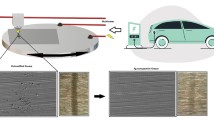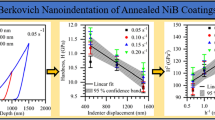Abstract
Friction is a complex process involving multi-scale asperity contact and large plastic deformation associated with the development of a dislocation structure. Friction is closely associated with the stick–slip phenomenon. In spite of the large number of papers, dedicated to stick–slip effects, little effort has been directed toward elucidating the development of the dislocation structure during stick–slip phenomena. Here, we report some new systematic investigations into the dislocation nature of stick–slips during low-velocity friction of a lithium fluoride single crystal rubbed against a spherical diamond indenter. It is shown that the average velocity of the indenter in the stick phase is about 300 times lower than the maximal velocity in the slip. This difference in velocities leads to entirely different dislocation behavior and damage development in the stick and slips phases. The stick phase is mainly determined by time-dependent strain (creep) wherein, as in metals and alloys, three stages of creep are observed. Based on the analysis of the dislocation structure, a model of the dislocation distribution in the regions of stick (creep) and slip is proposed.









Similar content being viewed by others
References
Bowden, F., Tabor, D.: The Friction and Lubrication of Solids. Clarendon, Oxford (1950)
Rabinowicz, E.: The nature of the static and kinetic coefficients of friction. J. Appl. Phys. 22, 1373–1379 (1958)
Persson, B.: Sliding Friction: Physical Principles and Applications. Springer, Heidelberg (1998)
Rapoport, L., Bilik, Y., Feldman, Y., et al.: Hollow nanoparticles of WS2 as potential solid-state lubricants. Nature 387, 791–793 (1997)
Scholz, C.: The Mechanics of Earthquakes and Faulting. Cambridge University Press, Cambridge (1990)
Lee, D., Banquy, X., Israelachvili, J.: Stick–slip friction and wear of articular joints. Proc. Natl. Acad. Sci. 28, E567–E574 (2013)
Urbakh, M., Klafter, J., Gourdon, D., Israelachvili, J.: The nonlinear nature of friction. Nature 430, 525–528 (2004)
Rabinovicz, E.: The intrinsic variables affecting the stick–slip process. Proc. Phys. Soc. Lond. 71, 668–675 (1958)
Heslot, F., Baumberger, T., Perrin, B., Caroli, B., Caroli, C.: Creep, stick–slip, and dry friction dynamics: experiments and a heuristic model. Phys. Rev. E 49, 4973–4988 (1994)
Baumberger, T., Heslot, F., Perrin, B.: Crossover from creep to inertial motion in friction dynamics. Nature 367, 544–546 (1994)
Baumberger, T., Gauthier, L.: Creeplike relaxation at the interface between rough solids under shear. J. Phys. 6, 1021–1030 (1996)
Rabinowicz, E.: Friction and Wear of Materials. Wiley, New York (1995)
Cho, M., Kim, S., Lim, D., Jang, H.: Atomic scale stick–slip caused by dislocation nucleation and propagation during scratching of a Cu substrate with a nanoindenter: a molecular dynamics simulation. Wear 259, 1392–1399 (2005)
Smith, R., Mulliah, D., Kenny, S., et al.: Stick slip and wear on metal surfaces. Wear 259, 459–466 (2005)
Filippov, A., Klafter, J., Urbakh, M.: Friction through dynamical formation and rupture of molecular bonds. Phys. Rev. Lett. 92, 135503-1–135503-4 (2004)
Müser, M.: How static is static friction? Proc. Natl. Acad. Sci. 105, 13187–13188 (2008)
Yang, Z., Zhang, H., Marder, M.: Dynamics of static friction. Proc. Natl. Acad. Sci. 105, 13264–13268 (2008)
Hurtado, J., Kim, K.: Scale effects in friction of single-asperity contacts. I. From concurrent slip to single-dislocation-assisted slip. Proc. R. Soc. Lond. A 455, 3363–3384 (1999)
Hurtado, J., Kim, K.: Scale effects in friction of single-asperity contacts. II. Multiple-dislocation-cooperated slip. Proc. R. Soc. Lond. A 455, 3385–3400 (1999)
Deshpande, V., Needleman, A., Van der Giessen, E.: Discrete dislocation plasticity analysis of static friction. Acta Mater. 52, 3135–3149 (2004)
Merkle, A., Marks, L.: A predictive analytical friction model from basic theories of interfaces, contacts and dislocations. Tribol. Lett. 26, 73–84 (2007)
M’ndange-Pfupfu, A., Marks, L.: A dislocation-based analytical model for the nanoscale processes of shear and plowing friction. Tribol. Lett. 39, 163–167 (2010)
Rapoport, L.: Peculiarities of LiF single-crystal deformation in vaseline oil at elevated temperatures. Wear 161, 23–28 (1993)
Harea, E., Lapsker, I., Laikhtman, A., Rapoport, L.: Bauschinger’s effect and dislocation structure under friction of LiF single crystals. Tribol. Lett. 52, 205–212 (2013)
Gilman, J., Johnston W.: Dislocations and mechanical properties of crystals. In: Fisher, J., Johnston, W., Thomson, R., Vreeland, T. (eds.), p. 116. Willey, New York (1957)
Kassner, M., Perez-Prado, M.: Fundamentals of Creep in Metals and Alloys. Elsevier, Oxford (2009)
Author information
Authors and Affiliations
Corresponding author
Rights and permissions
About this article
Cite this article
Perfilyev, V., Moshkovich, A., Lapsker, I. et al. Dislocation Structure and Stick–Slip Phenomenon. Tribol Lett 55, 295–301 (2014). https://doi.org/10.1007/s11249-014-0358-4
Received:
Accepted:
Published:
Issue Date:
DOI: https://doi.org/10.1007/s11249-014-0358-4




